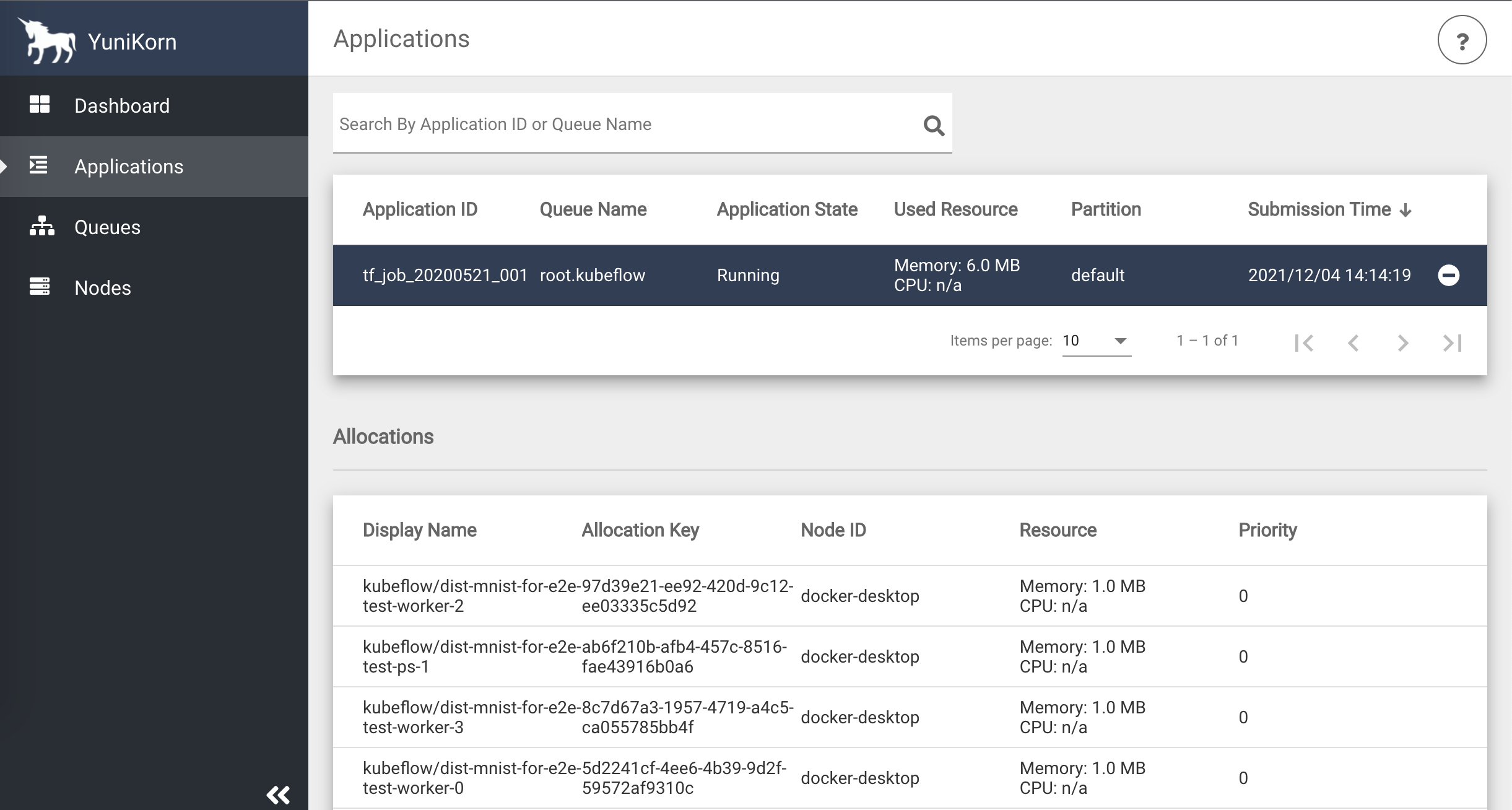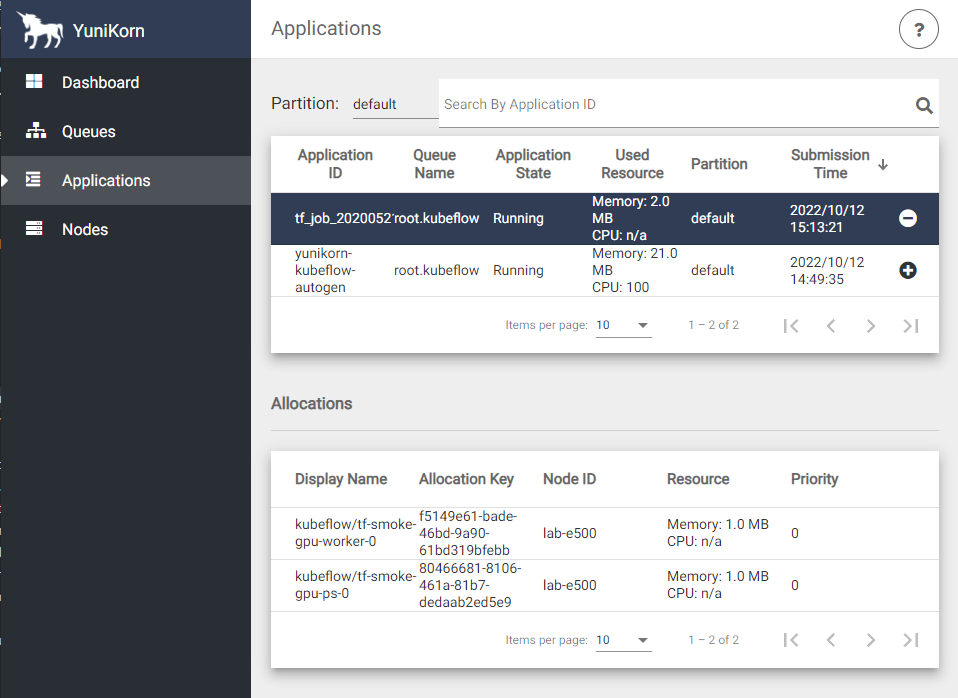Run TensorFlow Jobs
This guide gives an overview of how to set up training-operator and how to run a Tensorflow job with YuniKorn scheduler. The training-operator is a unified training operator maintained by Kubeflow. It not only supports TensorFlow but also PyTorch, XGboots, etc.
Install training-operator
You can use the following command to install training operator in kubeflow namespace by default. If you have problems with installation, please refer to this doc for details.
kubectl apply -k "github.com/kubeflow/training-operator/manifests/overlays/standalone?ref=v1.3.0"
Prepare the docker image
Before you start running a TensorFlow job on Kubernetes, you'll need to build the docker image.
- Download files from deployment/examples/tfjob
- To build this docker image with the following command
docker build -f Dockerfile -t kubeflow/tf-dist-mnist-test:1.0 .
Run a TensorFlow job
Here is a TFJob yaml for MNIST example.
apiVersion: kubeflow.org/v1
kind: TFJob
metadata:
name: dist-mnist-for-e2e-test
namespace: kubeflow
spec:
tfReplicaSpecs:
PS:
replicas: 2
restartPolicy: Never
template:
metadata:
labels:
applicationId: "tf_job_20200521_001"
queue: root.sandbox
spec:
schedulerName: yunikorn
containers:
- name: tensorflow
image: kubeflow/tf-dist-mnist-test:1.0
Worker:
replicas: 4
restartPolicy: Never
template:
metadata:
labels:
applicationId: "tf_job_20200521_001"
queue: root.sandbox
spec:
schedulerName: yunikorn
containers:
- name: tensorflow
image: kubeflow/tf-dist-mnist-test:1.0
Create the TFJob
kubectl create -f deployments/examples/tfjob/tf-job-mnist.yaml
You can view the job info from YuniKorn UI. If you do not know how to access the YuniKorn UI, please read the document here.

Run a TensorFlow job with GPU scheduling
To use Time-Slicing GPU your cluster must be configured to use GPUs and Time-Slicing GPUs This section covers a workload test scenario to validate TFJob with Time-slicing GPU.
Verify that the time-slicing configuration is applied successfully
kubectl describe node
Capacity:
nvidia.com/gpu: 8
...
Allocatable:
nvidia.com/gpu: 8
...
Create a workload test file tf-gpu.yaml
# tf-gpu.yaml
apiVersion: "kubeflow.org/v1"
kind: "TFJob"
metadata:
name: "tf-smoke-gpu"
namespace: kubeflow
spec:
tfReplicaSpecs:
PS:
replicas: 1
template:
metadata:
creationTimestamp:
labels:
applicationId: "tf_job_20200521_001"
spec:
schedulerName: yunikorn
containers:
- args:
- python
- tf_cnn_benchmarks.py
- --batch_size=32
- --model=resnet50
- --variable_update=parameter_server
- --flush_stdout=true
- --num_gpus=1
- --local_parameter_device=cpu
- --device=cpu
- --data_format=NHWC
image: docker.io/kubeflow/tf-benchmarks-cpu:v20171202-bdab599-dirty-284af3
name: tensorflow
ports:
- containerPort: 2222
name: tfjob-port
workingDir: /opt/tf-benchmarks/scripts/tf_cnn_benchmarks
restartPolicy: OnFailure
Worker:
replicas: 1
template:
metadata:
creationTimestamp: null
labels:
applicationId: "tf_job_20200521_001"
spec:
schedulerName: yunikorn
containers:
- args:
- python
- tf_cnn_benchmarks.py
- --batch_size=32
- --model=resnet50
- --variable_update=parameter_server
- --flush_stdout=true
- --num_gpus=1
- --local_parameter_device=cpu
- --device=gpu
- --data_format=NHWC
image: docker.io/kubeflow/tf-benchmarks-gpu:v20171202-bdab599-dirty-284af3
name: tensorflow
ports:
- containerPort: 2222
name: tfjob-port
resources:
limits:
nvidia.com/gpu: 2
workingDir: /opt/tf-benchmarks/scripts/tf_cnn_benchmarks
restartPolicy: OnFailure
Create the TFJob
kubectl apply -f tf-gpu.yaml
kubectl get pods -n kubeflow
NAME READY STATUS RESTARTS AGE
tf-smoke-gpu-ps-0 1/1 Running 0 18m
tf-smoke-gpu-worker-0 1/1 Running 0 18m
training-operator-7d98f9dd88-dd45l 1/1 Running 0 19m
Verify that TFJob are running.
-
In pod logs
kubectl logs tf-smoke-gpu-worker-0 -n kubeflow.......
..Found device 0 with properties
..name: NVIDIA GeForce RTX 3080 major: 8 minor: 6 memoryClockRate(GHz): 1.71
.......
..Creating TensorFlow device (/device:GPU:0) -> (device: 0, name: NVIDIA GeForce RTX 3080, pci bus id: 0000:01:00.0, compute capability: 8.6)
....... -
In node
...
Allocated resources:
(Total limits may be over 100 percent, i.e., overcommitted.)
Resource Requests Limits
-------- -------- ------
...
nvidia.com/gpu 2 2
... -
In Yunikorn UI applications
